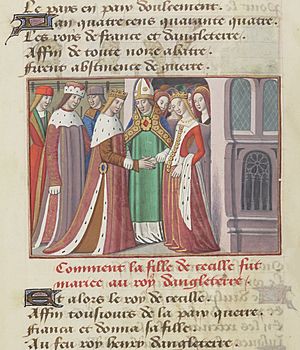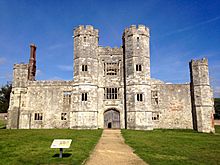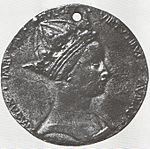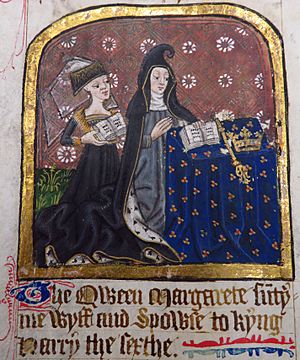Margaret of Anjou facts for kids
Quick facts for kids Margaret of Anjou |
|
|---|---|

Detail from the Talbot Shrewsbury Book
|
|
| Queen consort of England | |
| Tenure |
|
| Coronation | 30 May 1445 |
| Queen consort of France (disputed) | |
| Tenure | 23 April 1445 – 19 October 1453 |
| Born | 23 March 1430 Pont-à-Mousson, Duchy of Bar, Holy Roman Empire |
| Died | 25 August 1482 (aged 52) Dampierre-sur-Loire, Anjou, France |
| Burial | Angers Cathedral |
| Spouse | |
| Issue | Edward, Prince of Wales |
| House | Valois-Anjou |
| Father | René, King of Naples |
| Mother | Isabella, Duchess of Lorraine |
Margaret of Anjou (French: Marguerite; 23 March 1430 – 25 August 1482) was the Queen of England. She became queen by marrying King Henry VI in 1445. She was also called the Queen of France, but this was only a title. She ruled as queen from 1445 to 1461 and again from 1470 to 1471. Margaret was born in the Duchy of Lorraine. She belonged to the House of Valois-Anjou. Her parents were René, King of Naples, and Isabella, Duchess of Lorraine.
Margaret was a very important person in the Wars of the Roses. These were a series of civil wars in England. She often led the Lancastrian side. People at the time admired her "valiant courage and undaunted spirit." One historian said she was "more like to a man, than a woman" in her courage.
Because her husband, King Henry VI, often became mentally ill, Margaret ruled the country for him. She called a special meeting in 1455. This meeting left out the Yorkist group, led by Richard of York, 3rd Duke of York. This event started the civil war. The war lasted over 30 years. It caused many deaths, including her only son, Edward of Westminster, Prince of Wales. He died at the Battle of Tewkesbury in 1471.
After the Lancastrians lost at Tewkesbury, Margaret was captured. In 1475, her cousin, King Louis XI of France, paid for her freedom. She then lived in France, not as wealthy as before. She died there at age 52.
Contents
Early Life and Marriage to Henry VI
Margaret's Childhood and Family
Margaret was born on March 23, 1430. Her birthplace was Pont-à-Mousson in Lorraine. This area was part of the Holy Roman Empire. It was ruled by a branch of the French royal family. Margaret was the second daughter of René, King of Naples, and Isabella, Duchess of Lorraine. She had many brothers and sisters. Her father was known as "Good King René." He was the Duke of Anjou. He also had titles as king of Naples, Sicily, and Jerusalem. People said he was "a man of many crowns but no kingdoms."
Margaret spent her early years in castles in Provence and near Naples. Her mother oversaw her education. Margaret was interested in French stories and hunting. Her family had many strong women. They held power in politics and war. Her mother, Isabella, fought wars for her husband. Her grandmother, Yolande of Aragon, ruled Anjou as a regent. These women may have inspired Margaret's later actions. In England, it was less common for women to hold such power.
Marriage and the Loss of Maine
Margaret met English representatives in Tours on May 4, 1444. They talked about her marriage to Henry VI of England. On May 24, she was officially engaged to Henry. Her uncle, Charles VII of France, was there. He might have suggested the marriage. This was part of efforts to make peace between France and England. The marriage was mainly arranged by William de la Pole. Margaret's dowry was small. It was 20,000 francs. The agreement also included a truce with France for 23 months. Many hoped this marriage would bring true peace.


The English government borrowed money for Margaret's trip to England. They said the marriage would help bring peace with France. She arrived in England on April 9, 1445. She traveled to London with many lords. On May 28, she reached London. The city prepared for a huge crowd. People were expected to watch from roofs and balconies.
Her parade through London lasted two days. She spent one night in the Tower of London. There were eight plays performed during her parade. Five plays were about peace with France. They showed Margaret as a symbol of peace. Three plays spoke of her spiritual role.
On April 23, 1445, Margaret married King Henry VI of England. The wedding was at Titchfield Abbey in Hampshire. She was fifteen, and he was twenty-three. She was crowned Queen of England on May 30, 1445. This happened at Westminster Abbey. The wedding and her travel were very costly.
Soon after her coronation, Margaret's father, René, talked with the English. He wanted to trade a long alliance and a truce. In return, England would give up Maine to Anjou. Henry would also give up his claim to Anjou. The agreement ended with England losing Maine. There was no alliance with Anjou. False rumors spread that Maine was part of Margaret's marriage deal. People believed these rumors. Margaret and Henry wrote to Charles VII about the agreement. They tried to help make peace.
Losing Maine made the English public very angry. They already did not trust Margaret because she was French. People blamed William de la Pole for the loss. Margaret's marriage became less popular. But she was not openly blamed for losing Maine.
In their early marriage, Margaret and Henry spent much time together. They both liked learning and culture. In 1448, Margaret was allowed to start Queens' College, Cambridge. Before 1453, she did not do much in public politics. Most of her letters from this time are about helping people. She helped arrange marriages and return stolen property. These were normal duties for a queen. Some of her actions were successful. Others were seen as too bossy.
Birth of a Son and Henry's Illness
Henry was more interested in religion than in war. He was not a strong king. He had been king since he was a baby. Others had controlled his actions. When he married Margaret, his mind was already unstable. Their only son, Edward of Westminster, Prince of Wales, was born on October 13, 1453. By then, Henry had a complete mental breakdown.
The Start of the Wars of the Roses
Margaret and the Duke of York
Margaret focused on caring for her young son. She did not show much political interest at first. But she became worried that Richard of York, 3rd Duke of York, wanted to take her husband's throne. York was made Lord Protector while Henry was ill. This made Margaret very upset. The Duke of York had a strong claim to the throne. Many powerful nobles supported him.
Henry was easily influenced and often ill. Margaret was determined to keep the crown for her son. Some historians say Margaret's dislike of York caused the Lancastrian downfall. They also say she relied too much on unpopular friends. But Queen Margaret was a very powerful person in politics. King Henry often did what she wanted.
Some historians believe Margaret's dislike for York started later. They say it began in 1455. This was after the First Battle of St Albans. Margaret then saw York as a threat to the king. She had tried to treat York and Edmund Beaufort, 2nd Duke of Somerset, equally. She seemed to accept York as Protector at first. There is not much proof that she kept Yorkists out of the Great Council.
However, other historians say Margaret's friends, Edmund Beaufort and William de la Pole, convinced her. They told her York was too powerful. Margaret worked to have York removed from his post in France. She had him sent to Ireland instead.
In 1457, people were angry again. A French general, Pierre de Brézé, landed in England. He burned the town of Sandwich. He led 4,000 French soldiers. He wanted to use the chaos in England to his advantage. The mayor of Sandwich was killed. Because of this, the Mayor of Sandwich still wears a black robe today. Margaret was linked to de Brézé in rumors. Public anger was so high. Margaret had to let York's relative, Richard Neville, 16th Earl of Warwick, guard the sea.
Leading the Lancastrian Side
Fighting soon broke out between the Yorkist and Lancastrian groups. In May 1455, Henry VI recovered from his illness. York's time as Protector ended. Margaret called a Great Council. Yorkists were not invited. The Council called for nobles to gather at Leicester. They wanted to protect the king "against his enemies." York was ready for a fight. He marched south to meet the Lancastrian army.
The Lancastrians lost badly at the First Battle of St Albans. This was on May 22, 1455. Edmund Beaufort and others were killed. King Henry was captured by the Duke of York. In March 1458, Margaret joined her husband. They took part in The Love Day procession in London. This was with other nobles from both sides.
In 1459, fighting started again. This was at the Battle of Blore Heath. James Tuchet, 5th Baron Audley, was defeated there. He lost to a Yorkist army led by Richard Neville, 5th Earl of Salisbury.
The Wars of the Roses Continue
Early Battles and Victories
Margaret was in Scotland, getting more support for the Lancastrians. Her main commander, Henry Beaufort, 3rd Duke of Somerset, won a big victory. This was at the Battle of Wakefield on December 30, 1460. He defeated the armies of the Duke of York and the Earl of Salisbury. Both men were executed. Margaret was in Scotland, so she could not have ordered their deaths.
Next was the Second Battle of St Albans on February 17, 1461. Margaret was there. She defeated the Yorkist forces of Richard Neville, 16th Earl of Warwick. She also got her husband back. After this battle, she ordered the execution of two Yorkist prisoners. These men had guarded King Henry. They kept him safe during the battle. The king had promised them safety. But Margaret went against him and ordered their deaths. It is said she put them on trial with her son leading.
Time in France
The Lancastrian army was defeated at the Battle of Towton. This happened on March 29, 1461. The son of the Duke of York, Edward IV of England, won. He removed King Henry from the throne. Edward then declared himself king. Margaret was determined to get her son's right to the throne back. She fled with him to Wales and then to Scotland.
She then went to France. There, she made an ally of her cousin, King Louis XI of France. Louis XI helped her connect with Edward's former supporter, Richard Neville, Earl of Warwick. Warwick had fallen out with Edward. This was because Edward married Elizabeth Woodville. Warwick wanted revenge. Warwick's daughter, Anne Neville, married Margaret's son Edward. This made their alliance stronger. Margaret insisted Warwick return to England first. He did, and briefly put Henry VI back on the throne. This happened on October 3, 1470.
Final Defeat at Tewkesbury
By the time Margaret, her son, and daughter-in-law were ready to return to England, things had changed. The Yorkists were winning again. King Edward IV returned. He defeated and killed Warwick at the Battle of Barnet on April 14, 1471.
Margaret had to lead her own army at the Battle of Tewkesbury. This was on May 4, 1471. The Lancastrian forces lost. Her seventeen-year-old son, Edward of Westminster, was killed. The exact details of Edward's death are not clear. It is not known if he died in the battle or was executed afterward.
Over the past ten years, Margaret had become known for being tough. But after losing at Tewkesbury and her only son, she was heartbroken. William Stanley captured her. King Edward ordered her imprisonment. She was sent to Wallingford Castle. Then she was moved to the Tower of London. Henry VI was also imprisoned in the Tower. He died there on May 21. The cause of his death is not known. In 1472, she was placed with her former lady-in-waiting, Alice Chaucer, Duchess of Suffolk. She stayed there until King Louis XI of France paid for her freedom in 1475.
Later Years and Death
Margaret lived in France for seven years. She was not wealthy. She stayed with Francis de Vignolles. She died there, in his castle, on August 25, 1482. She was 52 years old. She was buried next to her parents in Angers Cathedral. But during the French Revolution, her remains were removed and scattered.
Margaret's Letters
Many letters written by Margaret as queen still exist. One was to the City of London. It was about harm to her tenants in Enfield. This land was part of her queen's income. Another letter was to the Archbishop of Canterbury. Margaret's letters often began with "By the Quene." They are collected in a book from 1863.
Margaret in Stories and Plays
Margaret is a main character in William Shakespeare's history plays. These include Henry VI, Part 1, Part 2, Part 3, and Richard III. She is the only character to appear alive in all four plays. Shakespeare shows Margaret as smart and strong. She easily controls her husband. She fights fiercely with her enemies. In Henry VI, Part 3, Richard Plantagenet calls her "She-wolf of France."
In real life, Margaret lived outside England after her husband and son died. But Shakespeare brings her back in Richard III. She acts like a prophet, predicting bad things. In her first appearance, she curses many nobles. She blames them for the downfall of the Lancastrian family. All her curses come true. The nobles are betrayed and executed by Richard of Gloucester. Each character thinks about her curse before they die. Shakespeare famously described Margaret: "How ill-beseeming is it in thy sex/ To triumph like an Amazonian trull."
Because of Shakespeare, many plays focus on Margaret. An adaptation called Margaret of Anjou was performed in London in 2016. Another adaptation of the Henry VI plays and Richard III was called War of the Roses. It gave Margaret a very important role. In 2018, the Royal Exchange theatre in Manchester showed Queen Margaret. This play used all of Margaret's lines from Shakespeare's plays. It also added new material.
|
See also
 In Spanish: Margarita de Anjou (1430-1482) para niños
In Spanish: Margarita de Anjou (1430-1482) para niños




